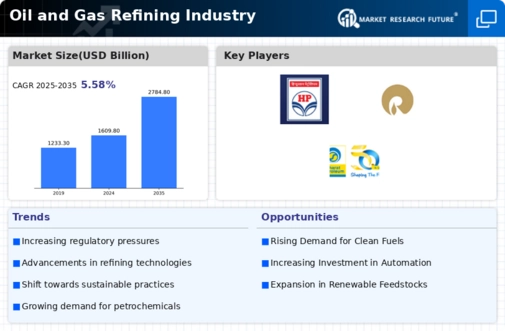Top Industry Leaders in the Oil Gas Refining Industry Market
*Disclaimer: List of key companies in no particular order
Top listed global companies in the Oil and Gas Refining industry are:
China National Petroleum Corporation
Indian Oil Corporation Limited
Exxonmobil Corporation
Chevron Corporation
Hindustan Petroleum Corporation Limited
PJSC Lukoil Oil Company
Petroleos De Venezuela, S.A.
Reliance Industries Limited
Marathon Petroleum Corporation
BP Plc
Bharat Petroleum Corporation Limited
Royal Dutch Shell Plc.
Bridging the Gap by Exploring Top Leaders Competitive Landscape of the Oil and Gas Refining Market
The oil and gas refining industry, a complex and dynamic ecosystem, is constantly evolving amidst a confluence of factors – fluctuating crude prices, geopolitical shifts, technological advancements, and the ever-present specter of climate change. This intricate dance shapes the competitive landscape, where established giants and emerging players jockey for market share, employing diverse strategies to secure their foothold.
Key Player Strategies:
- Integration and Diversification: Integrated oil and gas giants like ExxonMobil and Shell are leveraging their upstream and downstream operations to optimize crude sourcing, refining, and product distribution. Diversification into petrochemicals and renewable energy is another key strategy, mitigating exposure to oil price volatility.
- Regional Focus and M&A: Regional players like Sinopec and Reliance Industries are capitalizing on burgeoning domestic demand in Asia, expanding their refining capacities and acquiring assets in strategic locations. Mergers and acquisitions (M&A) are also seen as a means to gain scale, optimize logistics, and access new markets.
- Operational Excellence and Efficiency: Refineries are relentlessly pursuing operational excellence through automation, digitalization, and advanced process controls. This reduces costs, improves yields, and minimizes environmental impact, giving companies a competitive edge.
- Technological Innovation: Investing in next-generation refining technologies for cleaner fuels, biofuels production, and carbon capture and storage (CCS) is becoming paramount. Companies like Chevron and Valero are leading the charge, aiming to future-proof their operations and cater to evolving environmental regulations.
Factors for Market Share Analysis:
- Refining Capacity and Utilization: Refining capacity, measured in barrels per day (bpd), is a key indicator of a company's market share and production potential. Utilization rates, reflecting how efficiently refineries operate, also play a crucial role.
- Product Portfolio and Geographic Reach: The diversity and quality of refined products offered, along with the geographic reach of distribution networks, influence a company's competitiveness.
- Financial Performance and Market Access: Strong financial performance, including profitability and debt-to-equity ratios, indicates a company's stability and ability to invest in growth. Access to favorable crude oil sources and efficient logistics networks further bolster market share.
- Sustainability Initiatives and Regulatory Compliance: As environmental concerns gain traction, companies embracing sustainability initiatives like cleaner fuels and emissions reduction technologies are gaining favor. Adherence to stringent regulatory requirements also ensures long-term viability.
New and Emerging Trends:
- Renewable Energy Integration: Refineries are exploring ways to integrate renewable energy sources like biofuels and hydrogen into their operations, reducing reliance on fossil fuels and opening up new revenue streams.
- Circular Economy and Waste Management: Minimizing waste and adopting circular economy principles through reprocessing and recycling are becoming priorities, driven by environmental regulations and resource scarcity.
- Digitalization and Automation: The adoption of advanced analytics, artificial intelligence, and automation is transforming refinery operations, optimizing processes, and improving safety.
- Focus on Specialty Products: Niche markets for high-performance fuels, lubricants, and petrochemicals are attracting increasing attention, offering avenues for differentiation and growth.
Overall Competitive Scenario:
The oil and gas refining industry is characterized by intense competition, with established players defending their turf while new entrants seek opportunities. The rise of Asia as a major consumer market is reshaping the landscape, with regional players flexing their muscles. Technological innovation and the quest for sustainable operations are becoming critical differentiators, forcing companies to adapt and evolve. While the future remains uncertain, those who embrace agility, innovation, and a commitment to environmental responsibility are best positioned to navigate the labyrinth and emerge as leaders in this dynamic industry.
Latest Company Updates:
China National Petroleum Corporation (CNPC):
- The company reported a 6% increase in refining throughput in 2023 compared to 2022. (Source: CNPC official website)
Indian Oil Corporation Limited (IOCL):
- The company recently commissioned a new 12 MMTPA refinery in Paradip, Odisha. (Source: IOCL official website)
ExxonMobil Corporation:
- The company is investing in biofuels and carbon capture technologies to reduce its emissions and diversify its business. (Source: ExxonMobil press release)
Chevron Corporation:
- The company is investing in its refining and petrochemical businesses in Asia and the Middle East. (Source: Chevron investor presentation)
Hindustan Petroleum Corporation Limited (HPCL):
- The company is also focusing on increasing its marketing and retail footprint across India. (Source: HPCL official website)









